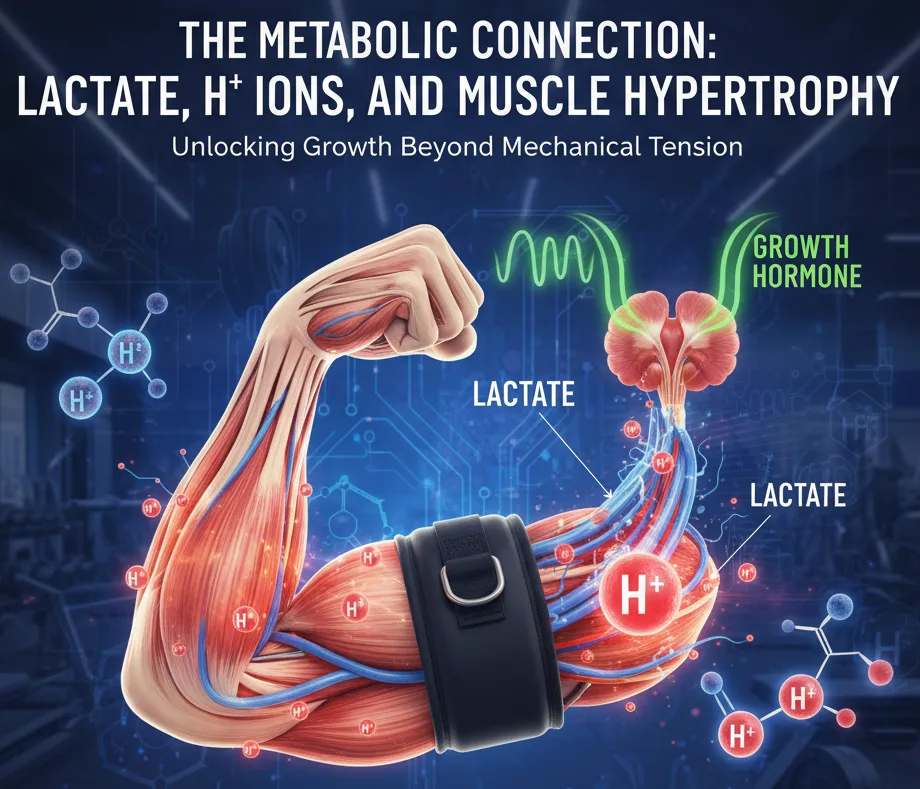The pursuit of muscle growth (hypertrophy) is a cornerstone of resistance training. While the primary driver is indisputably mechanical tension—the force placed on muscle fibers—a secondary, yet crucial, stimulus comes from metabolic stress. This stress is a physiological response to the buildup of specific compounds in the muscle cell, creating a unique environment that signals the body to adapt and grow. Key players in this process are lactic acid, its ionized form lactate, and hydrogen ions (H⁺).
Lactic Acid, Lactate, and H⁺: Separating Fact from Fiction
For decades, lactic acid was demonized as a painful, muscle-fatiguing waste product. This view has been largely revised by modern exercise physiology. Here's a more accurate breakdown:
-
Lactic Acid vs. Lactate: The term "lactic acid" is often used incorrectly. During high-intensity exercise, when muscles can't get enough oxygen, the body relies on anaerobic glycolysis for energy. The end-product of this process is pyruvate, which is then converted into a molecule of lactate. The creation of lactate is always accompanied by a hydrogen ion (H⁺). Lactic acid itself is an unstable intermediate that very quickly dissociates into these two components. So, while "lactic acid" is a precursor, it's the buildup of lactate and H⁺ that is physiologically significant.
-
The H⁺ Ion: The True Culprit of "The Burn": The familiar burning sensation and the feeling of muscle fatigue are primarily caused by the accumulation of hydrogen ions (H⁺). This buildup lowers the muscle's pH, making the environment more acidic. This acidity can interfere with muscle contraction, providing the body with a powerful signal that it's working hard and needs to adapt.
-
Lactate's True Role: More Than Just a Byproduct: Far from being a waste product, lactate is now understood to be a valuable metabolic fuel. It can be shuttled from fast-twitch fibers to neighboring slow-twitch fibers to be used as a fuel source. It can also be transported to the heart, brain, and liver to be converted into glucose for energy. Most importantly for hypertrophy, lactate is now recognized as a critical signaling molecule that directly contributes to the anabolic cascade leading to muscle growth.
The Link Between Metabolic Stress and Muscle Hypertrophy
The temporary buildup of lactate and H⁺ ions and the subsequent metabolic stress contribute to muscle growth through several distinct mechanisms:
-
Hormonal Response: The acute increase in lactate levels following intense exercise has been shown to stimulate the release of Growth Hormone (GH). GH is a potent anabolic hormone that, in turn, stimulates the production of Insulin-like Growth Factor 1 (IGF-1). Both of these hormones are crucial for triggering muscle protein synthesis and facilitating muscle repair. This hormonal cascade is one of the key ways metabolic stress drives hypertrophy.
-
Increased Muscle Fiber Recruitment: The acidic environment created by H⁺ ions can inhibit the function of Type I (slow-twitch) muscle fibers. This inhibition effectively forces the body to recruit more of the larger, stronger Type II (fast-twitch) muscle fibers to sustain the effort. Since Type II fibers have the greatest capacity for growth, their increased recruitment is a direct pathway to greater hypertrophy.
-
Cell Swelling (The Pump): Metabolic stress causes an influx of fluid and blood into the muscle, creating a phenomenon known as cellular swelling or "the pump." This swelling places tension on the muscle cell membrane, which the body interprets as a threat to its structural integrity. This mechanical tension acts as a signaling mechanism, triggering anabolic pathways that lead to an increase in muscle protein synthesis and cell repair, ultimately contributing to muscle growth.
Blood Flow Restriction (BFR) Training: Leveraging Metabolic Stress
Blood Flow Restriction (BFR) training is a training methodology specifically designed to maximize metabolic stress with very low mechanical loads. This makes it an incredibly useful tool for individuals who are injured, in rehabilitation, or those who cannot handle heavy weights.
How BFR Works
-
Targeted Occlusion: A specialized cuff or band is placed around the upper portion of a limb. This cuff is inflated to a precise pressure to partially restrict arterial inflow (blood coming in) and significantly restrict venous return (blood leaving the muscle).
-
Rapid Hypoxia: By trapping blood in the muscle, BFR creates a state of hypoxia (low oxygen) within the muscle cells.
-
Accelerated Lactate Buildup: Without a sufficient oxygen supply, the muscle is forced to rely almost exclusively on anaerobic metabolism. This rapidly accelerates the buildup of lactate and H⁺ ions, creating extreme metabolic stress even when using light exercises (typically 20–40% of your one-repetition maximum, or 1RM).
-
Hypertrophy at Low Loads: This high level of metabolic stress effectively "tricks" the body into activating the same anabolic responses—like hormone release and Type II fiber recruitment—that are normally associated with heavy, high-intensity lifting.
Studies have consistently shown that BFR training with very light weights can produce hypertrophy and strength gains that are comparable to traditional heavy resistance training.
BFR Protocols
BFR training follows specific protocols to maximize its effects while ensuring safety. A common approach involves using:
-
Low Loads: Using only 20–40% of 1RM.
-
High Repetitions & Short Rests: Performing a high total volume of repetitions across multiple sets, such as four sets with 30 seconds of rest between them (e.g., 30 reps, then three sets of 15 reps). The cuff remains inflated for the duration of the working sets and rest periods.
By expertly manipulating blood flow, BFR training exemplifies how the metabolic cascade initiated by lactate and H⁺ accumulation can be a powerful and independent trigger for muscle growth, offering an effective alternative for a wide range of training goals.

